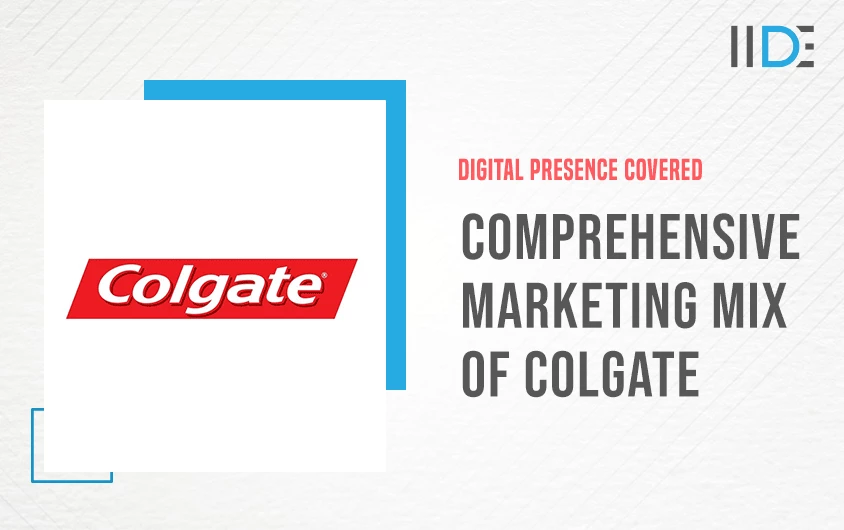Colgate is an American brand, which produces oral hygiene products such as toothpaste, toothbrush, mouthwash. It has extended its quantity and variety of products extensively over the years, to be more and more strong.
In this blog, we will cover the 4Ps strategy of the marketing mix of Colgate in detail, but before that let us know about the company.
About Colgate

Colgate is an oral hygiene care company that is now a universal product and is sold across countries. The company was founded by William Colgate and its headquarters is situated in New York, USA.
During the early stages, it used to sell soaps only, since 1873, it began to sell toothpaste in jars, and tubes were introduced later. The company gained a lot of popularity with the slogan “It Cleans Your Breath While It Cleans Your Teeth”. According to research in 2015, Kantar Worldpanel claimed that Colgate is the only brand in the world that is purchased by more than 50% of all households. They cover 67.7% of the global market penetration and 45% market share.
Specifically in India, Colgate is one of the leading oral hygiene products. It has an enriched portfolio of different products like Colgate® Sensitive Prevent & Repair™ Toothpaste, Colgate® Kids My First® Fluoride-free Toothpaste, and many more.
What’s new with this brand
- Colgate-Palmolive Webcasts Presentation at the Barclays 2023 Global Consumer Staples Conference.
Colgate-Palmolive Chairman, President, and CEO, Noel Wallace, presented on Wednesday, September 6, 2023, at 7:30 a.m. ET at the Barclays 2023 Global Consumer Staples Conference.
- Andhra Pradesh Government and Colgate-Palmolive join hands for Oral Health Awareness with Project Dr YSR Chirunavvu.
This began on the 1st of September at a school in the Nellore district, where Colgate-Palmolive India worked with the state government to educate children on oral health and build awareness on saying ‘No’ to tobacco.
- Announcement of results for the quarter ended 30th June 2023, double-digit net sales record @ 12.8%.
Colgate-Palmolive (India) Limited today reported Net Sales growth of 10.8% over the same quarter of the previous year aggregating to Rs. 1314.7 crore for the quarter ended June 30, 2023. Reported Net profit after tax for the quarter was Rs. 273.7 crore, a growth of 30.5% as against the Net Profit of Rs. 209.7 crore for the same quarter of the previous year.
Buyer Persona

Buyer’s Persona
Name:
Bhakti Gupta
Place:
Mumbai
Age:
20 years
Profession:
College student
Motivation
- Teeth whitening
- Nice breath
- Keeps gums healthy
Interest & Hobbies
- Reading
- Singing
- Drawing
- Playing badminton
Pain Points
- Inconsistent information on social media channels.
- Sometimes misleading information.
- Stock Availability.
Social Media Presence
- Youtube
Marketing Mix of Colgate
The term “Marketing Mix” indicates the collection of marketing techniques that are used by a company to achieve its marketing objective in a target market. It is a foundation model of a business that normally focuses on the 4Ps, which are product, pricing, place, and promotion.
Thus, it helps a business to cover its marketing and business strategies. Let’s understand the marketing mix of Colgate.
1. Product Strategy of Colgate
 It has mouth powder and mouthwashes which are for a special segment of people who are too sensitive to oral care, these products are for fresh and clean mouth smells. Colgate has 3 major product lines- toothpaste, mouthwash and toothbrushes. It has added a variety of different products vastly over time. Around 13 different types of toothpaste help with various oral problems, and over 500 types of toothbrushes are available.
It has mouth powder and mouthwashes which are for a special segment of people who are too sensitive to oral care, these products are for fresh and clean mouth smells. Colgate has 3 major product lines- toothpaste, mouthwash and toothbrushes. It has added a variety of different products vastly over time. Around 13 different types of toothpaste help with various oral problems, and over 500 types of toothbrushes are available.
Colgate produces multiple kinds of products under the same product line for different types of audiences so that a consumer can get whatever they want under the same brand and they don’t switch. The company also has a separate segment for kids in which they have a toothbrush with soft bristles so that they reach every corner of the mouth.
2. Price Strategy of Colgate
To have a perfect marketing mix, Colgate follows the discrimination of price a lot. This discrimination refers to the variety of prices for different products. They have different prices for different segments.
As oral hygiene is part of an oligopoly market, there are a small number of sellers in this market, but the number of purchasers is huge. In India, Colgate has several competitors hence it uses competitive pricing also for the same kind of segments. It uses the psychology of consumers by displaying that its products last long and have significant long-lasting effects. The products are available in various packs and combination offers which attract customers and enable them to pay extra.
3. Place and Distribution Strategy of Colgate
Colgate has been doing business for more than 150 years and it operates its activities in more than 200 countries. To control this perfectly it has amassed a massive distribution network. Their placements depend on their extensive distribution network. The Colgate company manufactures its oral hygiene products massively and distributes them to retailers across the world.
The company controls the marketing campaigns as well as the manufacturing of products. After completing the manufacturing, these products are packaged for shipment. Retailers collect their products from their dedicated shipments. Retailers finally sell these products to the audiences or customers of the market.
As Colgate has become one of the most selling products in India, it can be found in almost every retail shop and supermarket. Colgate products are sold at 2 million stores in India, to learn in detail read this. Their products are also distributed in many hotels and motels.
4. Promotion Strategy of Colgate
The advertising campaigns of Colgate are at their best. Colgate’s promotion strategy focuses on advertisements through media channels, such as television, online commercials, sponsorship, social media sites, social media influencers, and so on.
The company airs commercial ads on television worldwide in different national languages. In 2004, Colgate launched an oral health awareness campaign in India named – ‘Oral Health Month’. This campaign included free in-clinic dental check-ups. It also launched a campaign named “Spreading a million smiles with a mobile” to boost awareness throughout the nation. And this still occurs around every year. They also introduced a TVC campaign named #SmileKaroAurShuruHoJao and the purpose is to spread smiles all over India.
All its marketing and promotional activities are engaging to the customer which makes a connection with them and leads to a loyal customer base. It also uses various celebrities and doctors in its advertisements which makes those ads relatable for consumers.
How does this brand use digital marketing in its strategy?
- Social Media Presence: Colgate had established a strong presence on major social media platforms like Facebook, Instagram, Twitter, and YouTube. They used these platforms to share informative content, engage with customers, and run advertising campaigns. Social media allowed them to connect with a global audience and create brand loyalty.
- Content Marketing: Colgate created and shared valuable content related to oral health and hygiene. This content included articles, videos, and infographics that educated consumers about the importance of dental care. This not only positioned Colgate as an authority in oral health but also promoted its products indirectly.
- Influencer Marketing: Colgate collaborated with influencers and dental professionals to promote their products. Dentists and oral health experts often endorsed Colgate products, helping to build trust among consumers.
- Email Marketing: Colgate employed email marketing campaigns to reach out to customers with personalized product recommendations, promotions, and educational content. They used data analytics to segment their email lists and tailor their messages.
- Search Engine Optimization (SEO): Colgate optimized its website and online content to rank well in search engine results. This helped them attract organic traffic from people searching for dental care information and products.
Top Competitors
- Procter & Gamble (P&G): It is a multinational consumer goods company that produces a wide range of products, including oral care products under brands like Crest and Oral-B.
- Johnson & Johnson: It is another major player in the oral care market, with brands like Listerine and Reach in its portfolio.
- Unilever: It offers oral care products under the brand name Signal, as well as other personal care brands like Close-Up.
- GlaxoSmithKline (GSK): It owns brands such as Sensodyne, Parodontax, and Aquafresh, which compete in the oral care market.
- Church & Dwight Co., Inc.: This company owns brands like Arm & Hammer and Orajel, which offer a range of oral care and dental hygiene products.
Conclusion
Colgate has been a successful company in terms of both quality & variety of products. Their price is not so high for the customers to afford. As a result, it is affordable for both the audience and the industry. Their geographical reach is commendable for all types of customers. The company needs to work on its innovation strategy and expand itself in different markets to become a market leader. Overall the company is doing good in the industry and can sustain its position.
Liked the blog? Do check out our Free Digital Marketing Masterclass to learn more about digital marketing and its attributes. If you want to have a look at the case study of the ITC brand, here you go.
Thank you for taking the time to read the blog. Do comment with your thoughts below.





![50+ Google Ranking Factors Every Digital Marketer Should Know in [year]](https://iide.co/wp-content/w3-webp/uploads/2021/09/Google-Ranking-Factors-Featured-Image-400x250.pngw3.webp)
![Top 9 Digital Marketing Agencies in Dubai To Hire in [year]](https://iide.co/wp-content/w3-webp/uploads/2022/01/digital-marketing-agencies-in-dubai-featured-image-396x250.pngw3.webp)
0 Comments